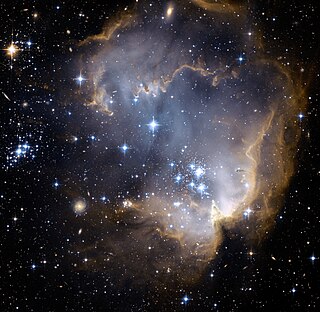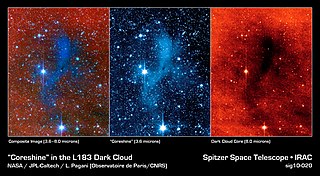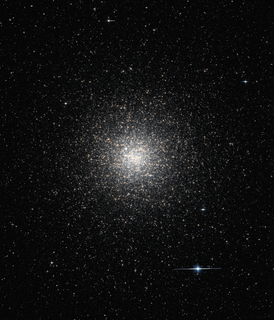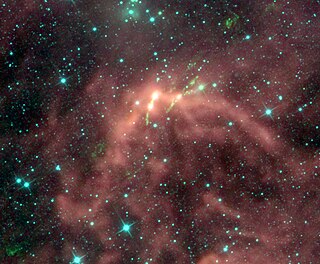Related Research Articles

In astronomy, the main sequence is a continuous and distinctive band of stars that appears on plots of stellar color versus brightness. These color-magnitude plots are known as Hertzsprung–Russell diagrams after their co-developers, Ejnar Hertzsprung and Henry Norris Russell. Stars on this band are known as main-sequence stars or dwarf stars. These are the most numerous true stars in the universe, and include the Earth's Sun.

A star is an astronomical object consisting of a luminous spheroid of plasma held together by its own gravity. The nearest star to Earth is the Sun. Many other stars are visible to the naked eye at night, but due to their immense distance from Earth they appear as fixed points of light in the sky. The most prominent stars are grouped into constellations and asterisms, and many of the brightest stars have proper names. Astronomers have assembled star catalogues that identify the known stars and provide standardized stellar designations. The observable universe contains an estimated 1022 to 1024 stars, but most are invisible to the naked eye from Earth, including all individual stars outside our galaxy, the Milky Way.

Stellar evolution is the process by which a star changes over the course of time. Depending on the mass of the star, its lifetime can range from a few million years for the most massive to trillions of years for the least massive, which is considerably longer than the age of the universe. The table shows the lifetimes of stars as a function of their masses. All stars are formed from collapsing clouds of gas and dust, often called nebulae or molecular clouds. Over the course of millions of years, these protostars settle down into a state of equilibrium, becoming what is known as a main-sequence star.
The Roche lobe is the region around a star in a binary system within which orbiting material is gravitationally bound to that star. It is an approximately teardrop-shaped region bounded by a critical gravitational equipotential, with the apex of the teardrop pointing towards the other star (the apex is at the L1 Lagrangian point of the system).

A protostar is a very young star that is still gathering mass from its parent molecular cloud. The protostellar phase is the earliest one in the process of stellar evolution. For a low mass star, it lasts about 500,000 years. The phase begins when a molecular cloud fragment first collapses under the force of self-gravity and an opaque, pressure supported core forms inside the collapsing fragment. It ends when the infalling gas is depleted, leaving a pre-main-sequence star, which contracts to later become a main-sequence star at the onset of hydrogen fusion producing helium.
Upsilon Capricorni, Latinized from υ Capricorni, is a solitary star in the southern constellation of Capricornus. It has a reddish hue and is dimly visible to the naked eye with an apparent visual magnitude of 5.17. The star is about 730 light years from the Sun based on parallax, but is drifting closer with a radial velocity of −12 km/s. It is 0.22 degree north of the ecliptic, so is subject to lunar occultations.

The Hayashi track is a luminosity–temperature relationship obeyed by infant stars of less than 3 M☉ in the pre-main-sequence phase of stellar evolution. It is named after Japanese astrophysicist Chushiro Hayashi. On the Hertzsprung–Russell diagram, which plots luminosity against temperature, the track is a nearly vertical curve. After a protostar ends its phase of rapid contraction and becomes a T Tauri star, it is extremely luminous. The star continues to contract, but much more slowly. While slowly contracting, the star follows the Hayashi track downwards, becoming several times less luminous but staying at roughly the same surface temperature, until either a radiative zone develops, at which point the star starts following the Henyey track, or nuclear fusion begins, marking its entry onto the main sequence.

R136 is the central concentration of stars in the NGC 2070 star cluster, which lies at the centre of the Tarantula Nebula in the Large Magellanic Cloud. When originally named it was an unresolved stellar object but is now known to include 72 class O and Wolf–Rayet stars within 5 parsecs of the centre of the cluster. The extreme number and concentration of young massive stars in this part of the LMC qualifies it as a starburst region.

NGC 602 is a young, bright open cluster of stars located in the Small Magellanic Cloud (SMC), a satellite galaxy to the Milky Way. It is embedded in a nebula known as N90.

LH 95 is a modestly sized stellar nursery in the Large Magellanic Cloud. It is related to the HII-region LHA 120-N 64, that is, a region of hydrogen ionized by the bright stars of LH 95.
HD 223311 is a star in the equatorial constellation of Aquarius. It has an orange hue and is visible to the naked eye as a dim star with an apparent visual magnitude of 6.08. Based on parallax measurements, the star is located at a distance of approximately 910 light years from the Sun. It is a radial velocity standard star that is drifting closer to the Sun at the rate of −20 km/s. The star is situated near the ecliptic and thus is subject to lunar occultations.

Diazenylium is the chemical N2H+, an inorganic cation that was one of the first ions to be observed in interstellar clouds. Since then, it has been observed for in several different types of interstellar environments, observations that have several different scientific uses. It gives astronomers information about the fractional ionization of gas clouds, the chemistry that happens within those clouds, and it is often used as a tracer for molecules that are not as easily detected (such as N2). Its 1–0 rotational transition occurs at 93.174 GHz, a region of the spectrum where Earth's atmosphere is transparent and it has a significant optical depth in both cold and warm clouds so it is relatively easy to observe with ground-based observatories. The results of N2H+ observations can be used not only for determining the chemistry of interstellar clouds, but also for mapping the density and velocity profiles of these clouds.

The Hertzsprung–Russell diagram, abbreviated as H–R diagram, HR diagram or HRD, is a scatter plot of stars showing the relationship between the stars' absolute magnitudes or luminosities versus their stellar classifications or effective temperatures. The diagram was created independently around 1910 by Ejnar Hertzsprung and Henry Norris Russell, and represented a major step towards an understanding of stellar evolution.

Coreshine is an astronomical term for infrared light scattered by unusually large grains of dust in the denser core regions of molecular clouds and which evidently begin their growth before the start of cloud collapse. These clouds which are opaque to visible light, are a mixture of gas and dust and are the regions where stars are formed.
7 Aquilae is a star in the equatorial constellation of Aquila, located 367 light years away from the Sun. 7 Aquilae is the Flamsteed designation. It is visible to the naked eye as a faint, yellow-white hued star with a baseline apparent visual magnitude of 6.9. The star is moving closer to the Earth with a heliocentric radial velocity of –29 km/s.

Zeta Indi is a single star in the southern constellation Indus, near the northern constellation border with Microscopium. It is visible to the naked eye as a faint, orange-hued star with an apparent visual magnitude of 4.90. The star is located approximately 430 light years away from the Sun based on parallax. The radial velocity estimate for this object is poorly constrained, but it appears to be moving closer at the rate of around −5 km/s.

R136c is a star located in R136, a tight knot of stars at the centre of NGC 2070, an open cluster weighing 450,000 solar masses and containing 10,000 stars. At 142 M☉ and 3.8 million L☉, it is the one of the most massive star known and one of the most luminous, along with being one of the hottest, at over 40,000 K. It was first resolved and named by Feitzinger in 1980, along with R136a and R136b.

UY Scuti (BD-12°5055) is a red supergiant star in the constellation Scutum. It is considered one of the largest known stars by radius and is also a pulsating variable star, with a maximum brightness of magnitude 8.29 and a minimum of magnitude 10.56. It has an estimated radius of 1,708 solar radii (1.188×109 kilometres; 7.94 astronomical units), thus a volume nearly 5 billion times that of the Sun. It is approximately 2.9 kiloparsecs (9,500 light-years) from Earth. If placed at the center of the Solar System, its photosphere would at least engulf the orbit of Jupiter.

NGC 6441 is a globular cluster in the southern constellation of Scorpius. It was discovered by the Scottish astronomer James Dunlop on May 13, 1826, who described it as "a small, well-defined rather bright nebula, about 20″ in diameter". The cluster is located 5 arc minutes east-northeast of the star G Scorpii, and is some 44,000 light years from the Sun.

The dark nebula Barnard 203 or Lynds 1448 is located about one degree southwest of NGC 1333 in the Perseus molecular cloud, at a distance of about 800 light-years. Three infrared sources were observed in this region by IRAS, called IRS 1, IRS 2 and IRS 3.